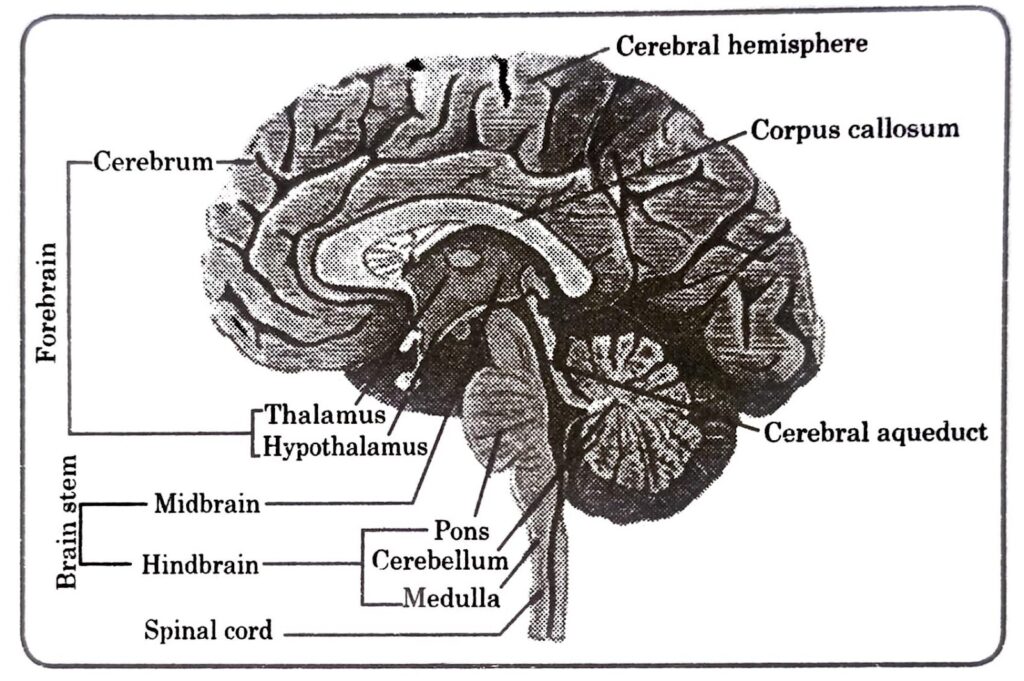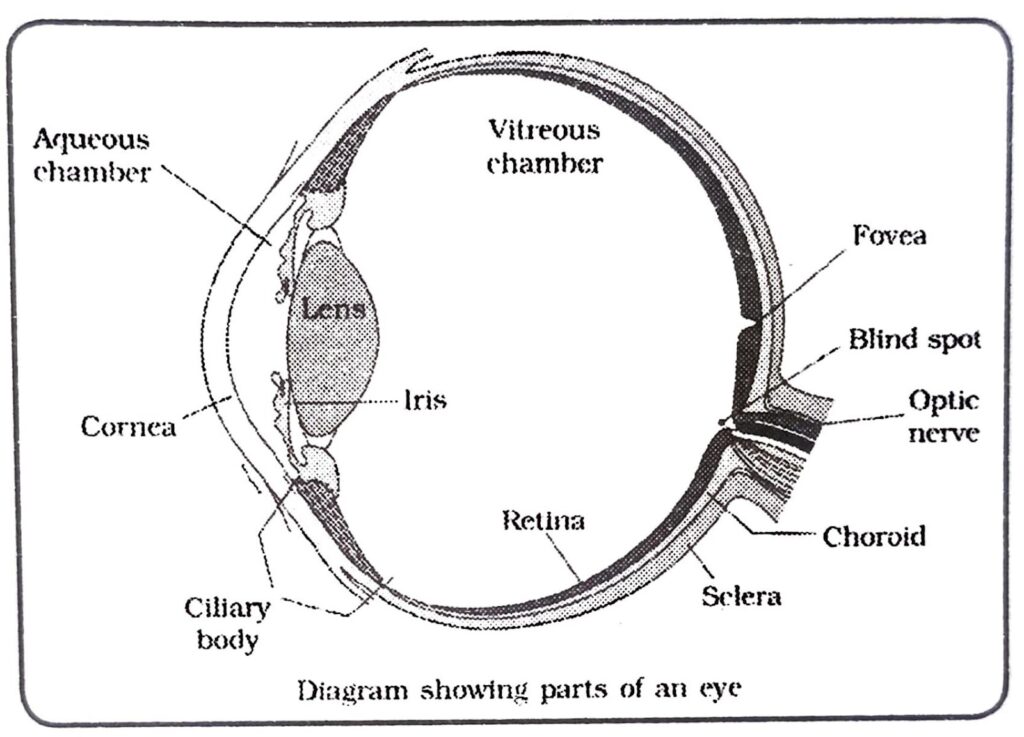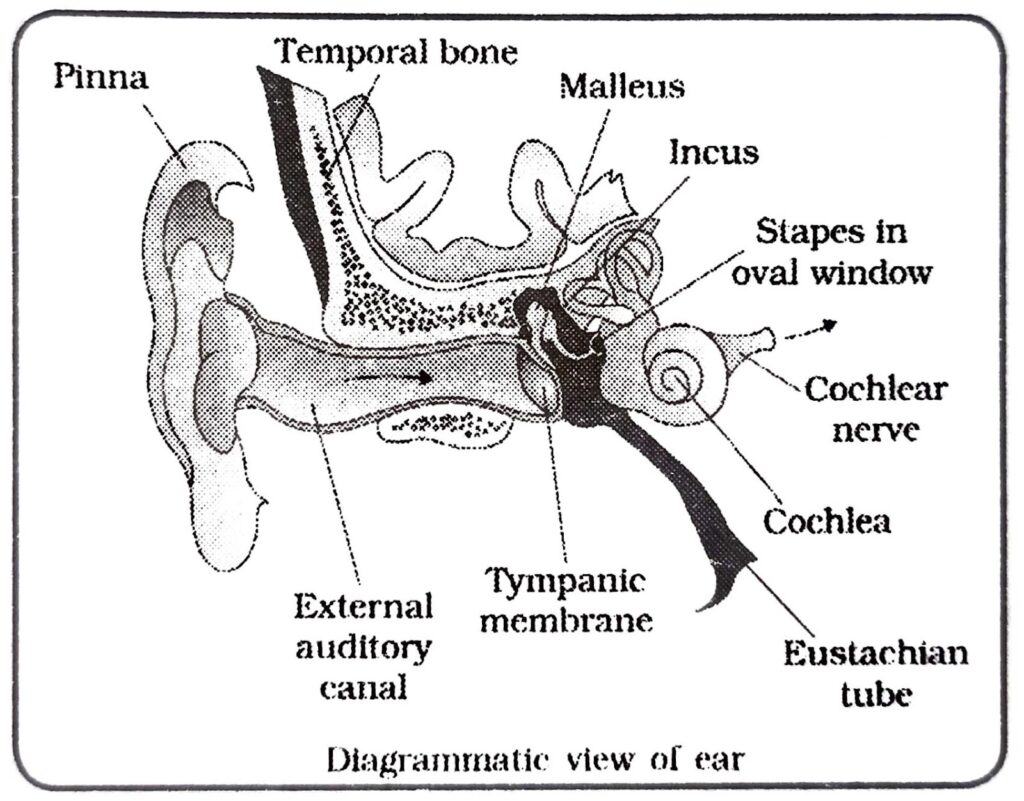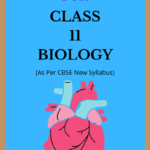NCERT Class 11 Biology Chapter 21 Neural Control and Coordination Solutions to each chapter is provided in the list so that you can easily browse through different chapters NCERT Class 11 Biology Chapter 21 Neural Control and Coordination and select need one. NCERT Class 11 Biology Chapter 21 Neural Control and Coordination Question Answers Download PDF. NCERT Biology Class 11 Solutions.
NCERT Class 11 Biology Chapter 21 Neural Control and Coordination
Also, you can read the NCERT book online in these sections Solutions by Expert Teachers as per Central Board of Secondary Education (CBSE) Book guidelines. CBSE Class 11 Biology Solutions are part of All Subject Solutions. Here we have given NCERT Class 11 Biology Chapter 21 Neural Control and Coordination Notes, NCERT Class 11 Biology Textbook for All Chapters, You can practice these here.
Neural Control and Coordination
Chapter: 21
BIOLOGY
TEXTUAL QUESTIONS ANSWERS
Q.1. Briefly describe the structure of the following:
(a) Brain.
Ans. Brain:
(a) Human brain lies inside the skull.
(b) Brain is covered by cranial meninges consisting of an outer layer called dura mater, middle layer called arachnoid and an inner layer pia mater.
(c) The brain can be divided into three major parts:
(i) forebrain.
(ii) midbrain. and
(iii) hindbrain.
(b) Eye.
Ans. Eye:
(i) Paired eyes are located in sockets of the skull called orbits.
(ii) The wall of the eye ball is composed of three layers: Sclera, Choroid and Retina.
(c) Ear.
Ans. Ear:
(i) The ears perform two sensory functions: hearing and maintenance of body balance.
(ii) Ear consists of three major sections: external ear, the middle ear and the internal ear.
Q.2. Compare the following:
(a) Central neural system (CNS) and Peripheral neural system (PNS).
Ans. CNS includes brain and spinal cord. PNS comprises of cranial and spinal nerves arising from CNS (brain and spinal cord).
(b) Resting potential and action potential.
Ans. The electrical potential difference across the resting plasma membrane is called resting potential. The electrical potential difference across the plasma membrane at the site of stimulus is called the action potential.
(c) Choroid and retina.
Ans. CHOROID:
(i) The middle layer of eye – choroid contains many blood vessels and looks bluish in colour.
(ii) It contains pigmented cells that absorb light and prevent reflection in the eye ball.
(iii) Choroid becomes thick in the anterior part to form ciliary body.
(iv) The ciliary body forms a pigmented and opaque structure called iris.
RETINA:
(a) The inner layer of eye is retina.
(b) It has three layers of neural cells from inside to outside: ganglion cells, bipolar cells & photoreceptor cells.
(c) There are two types of photoreceptor cells, rods and cones.
(d) Blind Spot:
(i) The optic nerves and blood vessels leave the eye ball at a point in retina called blind spot.
(ii) It contains no rods and cones. Therefore no image is formed at this spot.
(e) Macula lutea:
(i) There is a yellowish pigmented spot called macula lutea with a central pit called the fovea centralis at the posterior pole of the eye lateral to the blind spot.
3. Explain the following processes:
(a) Polarisation of the membrane of a nerve fibre.
Ans. POLARISATION or RESTNG STATE:
(i) When a neuron is not conducting any impulse i.e. resting, the axonal membrane is more permeable to potassium ions and impermeable to sodium ions & negatively charged proteins present in the axoplasm.
(i) Consequently, the axoplasm inside the axon contains high concentration of K⁺ and negatively charged proteins and low concentration of Na⁺. In contrast, the fluid outside the axon contains a low concentration of K⁺ and high concentration of Na⁺. This forms a concentration gradient.
(ii) These ionic gradients across the resting membrane are maintained by active transport of ions by the sodium-potassium pump which transports 3 Nat outwards for 2 K⁺ into the cell.
(iii) As a result, the outer surface of the axonal membrane has a positive charge while its inner surface becomes negatively charged and therefore is polarised.
(iv) The electrical potential difference across the resting plasma membrane is called resting potential and resting membrane as polarized state.
(b) Depolarisation of the membrane of a nerve fibre.
Ans. DEPOLARISATION:
(i) When a stimulus is applied at a site on the polarised membrane, the membrane at the site becomes freely permeable to Na⁺.
(ii) This leads to rapid influx of Na⁺.
(iii) As a result, outer surface of the membrane becomes negatively charged while inner side becomes positively charged and therefore is depolarised.
(iv) The electrical potential difference across the plasma membrane at the site of stimulus is called the action potential.
(c) Conduction of a nerve impulse along a nerve fibre.
Ans. CONDUCTION OF NERVE IMPULSE
NERVE IMPULSE is conducted along the axon membrane in the form of a wave of depolarisation and repolarization. Neurons are excitable cells because their membranes are in a polarised state.
(d) Transmission of a nerve impulse across a chemical synapse.
Ans. Chemical synapse:
(i) Chemical synapses have the membranes of pre- and postsynaptic neurons separated by a fluid-filled space called synaptic cleft.
(ii) Chemicals called neurotransmitters are involved in the transmission of impulses at these synapses.
(iii) Two main neurotransmitters are acetylcholine and nor adrenaline.
(iv) The axon terminals contain vesicles filled with these neurotransmitters.
(v) When an impulse (action potential) arrives at the axon terminal, there is movement of synaptic vesicles with the help of calcium ions. Synaptic vesicles fuse with pre synaptic membrane and release their neurotransmitters in the synaptic cleft.
(vi) The released neurotransmitters bind to their specific receptors, present on the postsynaptic membrane. This binding opens ion channels allowing the entry of ions which can generate a new potential in the postsynaptic neuron.
(vii) The new potential developed may be either excitatory or inhibitory.
Q.4. Draw labelled diagrams of the following:
(a) Neuron.
Ans.

(b) Brain.
Ans.

(c) Eye.
Ans.

(d) Ear.
Ans.

Q.5. Write short notes on the following:
(a) Neural coordination.
Ans. Neural coordination:
(i) The human neural system is divided into two parts: central neural system (CNS) and peripheral neural system (PNS).
(ii) CNS includes brain and spinal cord.
(iii) PNS comprises of cranial and spinal nerves arising from CNS (brain and spinal cord).
(iv) There are 12 pairs of cranial nerves and 31 pairs of spinal nerves.
(v) Nerve fibres of the PNS are of two types:
(a) afferent fibres.
(b) efferent fibres.
(vi) Afferent nerve fibres transmit impulses from tissues/organs to CNS.
(vii) Efferent fibres transmit regulatory impulses from CNS to the concerned peripheral tissues/ organs.
(viii) PNS is divided into two divisions called somatic neural system and autonomic neural system.
(ix) Somatic neural system includes nerves to skeletal muscles.
(x) Autonomic neural system transmits impulses from CNS to involuntary organs and smooth muscles of the body.
(xi) Autonomic neural system is further classified into sympathetic neural system and parasympathetic neural system.
(b) Forebrain.
Ans. Forebrain consists of cerebrum, thalamus and hypothalamus.
(c) Midbrain.
Ans. Midbrain: Midbrain is located between forebrain and hindbrain. Midbrain has a canal called the cerebral aqueduct. Midbrain has four lobes called corpora quadrigemina concerned with sight and hearing.
(d) Hindbrain.
Ans. Hindbrain:
(i) The hindbrain comprises pons, cerebellum and medulla (also called medulla oblongata).
(ii) Pons consists of nerve fibre tracts that interconnect different regions of the brain.
(iii) Cerebellum has convoluted surface to provide additional space for many more neurons.
(iv) Medulla of the brain is connected to spinal cord.
(v) Medulla contains centres which control respiration, cardiovascular reflexes and gastric secretions.
(e) Retina.
Ans. RETINA:
(a) The inner layer of eye is retina.
(b) It has three layers of neural cells from inside to outside: ganglion cells, bipolar cells & photoreceptor cells.
(c) There are two types of photoreceptor cells, rods and cones.
(d) Blind Spot:
(i) The optic nerves and blood vessels leave the eye ball at a point in retina called blind spot.
(ii) It contains no rods and cones. Therefore no image is formed at this spot.
(e) Macula lutea: There is a yellowish pigmented spot called macula lutea with a central pit called the fovea centralis at the posterior pole of the eye lateral to the blind spot.
(f) Ear ossicles.
Ans. Middle ear contains three ear ossicles called malleus, incus and stapes which are attached to one another in a chain like fashion. Malleus is attached to tympanic membrane and stapes is attached to the oval window of cochlea. Ear ossicles increase the efficiency of transmission of sound waves to the inner ear.
(g) Cochlea.
Ans. Cochlea: The coiled portion of the labyrinth is called cochlea. It is the main hearing organ. It consists of three chambers: upper scala vestibuli & lower scala tympani filled with perilymph & middle scala media filled with endolymph.
(h) Organ of corti.
Ans. Basal membrane in Cochlea has organ of corti which contains rows of hair cells that act as auditory receptors. Rows of the hair cells have tectorial membrane above them
(i) Synapse.
Ans. Synapse is formed by the membranes of a presynaptic neuron and a postsynaptic neuron, which may or may not be separated by a gap called synaptic cleft.A nerve impulse is transmitted from one neuron to another through junctions called synapses. There are two types of synapses: electrical synapses and chemical synapses
Q.6. Give a brief account of:
(a) Mechanism of synaptic transmission.
Ans. SYNAPSE:
(i) Synapse is formed by the membranes of a presynaptic neuron and a postsynaptic neuron, which may or may not be separated by a gap called synaptic cleft.
(ii) A nerve impulse is transmitted from one neuron to another through junctions called synapses.
(iii) There are two types of synapses: electrical synapses and chemical synapses.
(b) Mechanism of vision.
Ans. MECHANISM OF VISION:
(i) The light rays through cornea and lens focus on retina and generate impulses in rods and cones. Photopigments in the human eyes is composed of opsin (a protein) and retinal (an aldehyde of vitamin A).
(ii) Light induces dissociation of the retinal from opsin which changes the structure of opsin.
(iii) As a result, potential differences are generated in rods and cones.
(iv) This produces action potentials in bipolar cells followed by ganglion cells.
(v) These action potentials are transmitted by optic nerves to the visual cortex of the brain.
(vi) Brain analyses the neural impulses and recognizes the image formed on the retina.
(c) Mechanism of hearing.
Ans. MECHANISM OF HEARING:
(i) Pinna receives sound waves and directs them to the ear drum.
(ii) Ear drum/ Tympanic membrane transmit the sound waves through ear ossicles to oval window.
(iii) Vibrations are passed through the oval window to cochlear fluid to basilar membrane and then to hair cells pressing them against the tectorial membrane.
(iv) Impulses are transmitted by the auditory nerves to auditory cortex of brain where these impulses are analysed and the sound is recognised.
7. Answer briefly:
(a) How do you perceive the colour of an object?
Ans. Colour vision is functions of cones. There are three types of cones: porpyrosin, iodopsin and cyanopsin which respond to red, green and blue lights. The sensations of different colors are produced by various combinations of three types of cones and their Photopigments. When these cones are stimulated equally, a sensation of white light is produced.
(b) Which part of our body helps us in maintaining the body balance?
Ans. Crista and macula are the specific receptors of vestibular apparatus responsible for maintenance of balance and posture of the body.
(c) How does the eye regulate the amount of light that falls on the retina.
Ans. Iris has an opening in center called pupil. The diameter of the pupil is regulated by the muscle fibres of iris.
Q.8. Explain the following:
(a) Role of Na+ in the generation of action potential.
Ans. (i) When a stimulus is applied at a site on the polarised membrane, the membrane at the site becomes freely permeable to Na⁺.
(ii) This leads to rapid influx ofNa+.
(iii) As a result, outer surface of the membrane becomes negatively charged while inner side becomes positively charged and therefore is depolarised.
(iv) The electrical potential difference across the plasma membrane at the site of stimulus is called the action potential.
(b) Mechanism of generation of light-induced impulse in the retina.
Ans. (i) The light rays through cornea and lens focus on retina and generate impulses in rods and cones. Photopigments in the human eyes is composed of opsin (a protein) and retinal (an aldehyde of vitamin A).
(ii) Light induces dissociation of the retinal from opsin which changes the structure of opsin.
(iii) As a result, potential differences are generated in rods and cones.
(iv) This produces action potentials in bipolar cells followed by ganglion cells.
(v) These action potentials are transmitted by optic nerves to the visual cortex of the brain.
(vi) Brain analyses the neural impulses and recognizes the image formed on the retina.
(c) Mechanism through which a sound produces a nerve impulse in the inner ear.
Ans. (i) Pinna receives sound waves and directs them to the ear drum.
(ii) Ear drum/ Tympanic membrane transmit the sound waves through ear ossicles to oval window.
(iii) Vibrations are passed through the oval window to cochlear fluid to basilar membrane and then to hair cells pressing them against the tectorial membrane.
(iv) Impulses are transmitted by the auditory nerves to auditory cortex of brain where these impulses are analysed and the sound is recognised.
Q.9. Differentiate between:
(a) Myelinated and unmyelinated axons.
Ans. Myelinated nerve fibres:
(i) Have Schwann cells which form a myelin sheath around the axon.
(ii) The gaps between two adjacent myelin sheaths are called nodes of Ranvier.
(iii) Myelinated nerve fibres are found in spinal and cranial nerves.
(iv) Action potential jumps from one node of Ranvier to another (saltatory conduction) because depolarization occurs only in nodes of Ranvier.
(v) Conduction is faster than unmyelinated nerve fibre.
Unmyelinated nerve fibres
(i) It is enclosed by Schwann cell that does not form a myelin sheath.
(ii) It is commonly found in autonomous and somatic neural systems.
(iii) Action potential travels along the entire length of nerve fibre because depolarization occurs all along the entire length.
(b) Dendrites and axons.
Ans. Dendrites:
(i) Dendrites are short fibres which branch repeatedly and project out of the cell body.
(ii) It also contains Nissl’s granules.
(iii) These fibres transmit impulses towards the cell body.
Axon:
(i) The axon is a long fibre with branched distal end.
(ii) Axon does not have Nissl’s granules.
(iii) Cell membrane of axon is called axolemma and its cytoplasm as axoplasm.
(iv) Axon ends in group of branches called axon terminals.
(v) Axon terminal terminates as a bulb-like structure called synaptic knob which has synaptic vesicles containing chemicals called neurotransmitters.
(vi) The axons transmit nerve impulses away from the cell body to a synapse or to a neuro-muscular junction.
(c) Rods and cones.
Ans. Cones: The daylight (photopic) vision and colour vision are functions of cones. There are three types of cones: porpyrosin, iodopsin and cyanopsin which respond to red, green and blue lights.
Rods: Twilight (scotopic) vision is the function of the rods. The rods contain purplish-red protein called the rhodopsin or visual purple. Rhodopsin is made of protein opsin and retinal, Vitamin A derivative.
(d) Thalamus and Hypothalamus.
Ans. Thalamus: It is a major coordinating centre for sensory and motor signaling.
Hypothalamus: It has centres which control body temperature, appetite and thirst. It has neurosecretory cells which secrete hormones.
(e) Cerebrum and Cerebellum.
Ans. Cerebrum:
(i) The forebrain consists of cerebrum.
(ii) Cerebrum forms the major part of the human brain.
(iii) Cerebrum consists of left and right cerebral hemispheres.
(iv) Cerebral hemispheres are connected by a tract of myelinated nerve fibres called corpus callosum .
Cerebellum:
(i) The hindbrain comprises cerebellum.
(ii) The Cerebellum has convoluted surface to provide additional space for many more neurons.
Q.10. Answer the following:
(a) Which part of the ear determines the pitch of a sound?
Ans. Cochlea.
(b) Which part of the human brain is the most developed?
Ans. Cerebrum.
(c) Which part of our central neural system acts as a master clock?
Ans. Pineal gland.
Q.11. The region of the vertebrate eye, where the optic nerve passes out of the retina, is called the
(a) fovea.
(b) iris.
(c) blind spot.
(d) optic chaisma.
Ans. (c) blind spot.
Q.12. Distinguish between:
(a) Afferent neurons and efferent neurons.
Ans. Afferent nerve fibres transmit impulses from tissues/organs to CNS. Efferent fibres transmit regulatory impulses from CNS to the concerned peripheral tissues/organs.
(b) Impulse conduction in a myelinated nerve fibre and unmyelinated nerve fibre.
Ans. Myelinated nerve fibres:
(i) Have Schwann cells which form a myelin sheath around the axon.
(ii) The gaps between two adjacent myelin sheaths are called nodes of Ranvier.
(iii) Myelinated nerve fibres are found in spinal and cranial nerves.
(iv) Action potential jumps from one node of Ranvier to another (saltatory conduction) because depolarization occurs only in nodes of Ranvier.
(v) Conduction is faster than unmyelinated nerve fibre.
Unmyelinated nerve fibres
(i) It is enclosed by Schwann cell that does not form a myelin sheath.
(ii) It is commonly found in autonomous and somatic neural systems.
(iii) Action potential travels along the entire length of nerve fibre because depolarization occurs all along the entire length.
(c) Aqueous humor and vitreous humor.
Ans. The space between cornea and lens is called aqueous chamber and contains a thin watery fluid called aqueous humor.
The space between lens and retina is called vitreous chamber and is filled with a transparent gel called vitreous humor.
(d) Blind spot and yellow spot.
Ans. Blind Spot:
(i) The optic nerves and blood vessels leave the eye ball at a point in retina called blind spot.
(ii) It contains no rods and cones. Therefore no image is formed at this spot.
Yellow Spot:
(i) There is a yellowish pigmented spot called macula lutea with a central pit called the fovea centralis at the posterior pole of the eye lateral to the blind spot.
(ii) The fovea is a thinned-out portion of the retina which has only cone cells.
(iii) Fovea is the point where the visual acuity (resolution) is the greatest.
(e) Cranial nerves and spinal nerves.
Ans. Cranial nerves arise from brain. There are 12 pairs of cranial nerves.
Spinal nerves arise from spinal cord. There are 31 pairs of spinal nerves.

Hi! my Name is Parimal Roy. I have completed my Bachelor’s degree in Philosophy (B.A.) from Silapathar General College. Currently, I am working as an HR Manager at Dev Library. It is a website that provides study materials for students from Class 3 to 12, including SCERT and NCERT notes. It also offers resources for BA, B.Com, B.Sc, and Computer Science, along with postgraduate notes. Besides study materials, the website has novels, eBooks, health and finance articles, biographies, quotes, and more.




